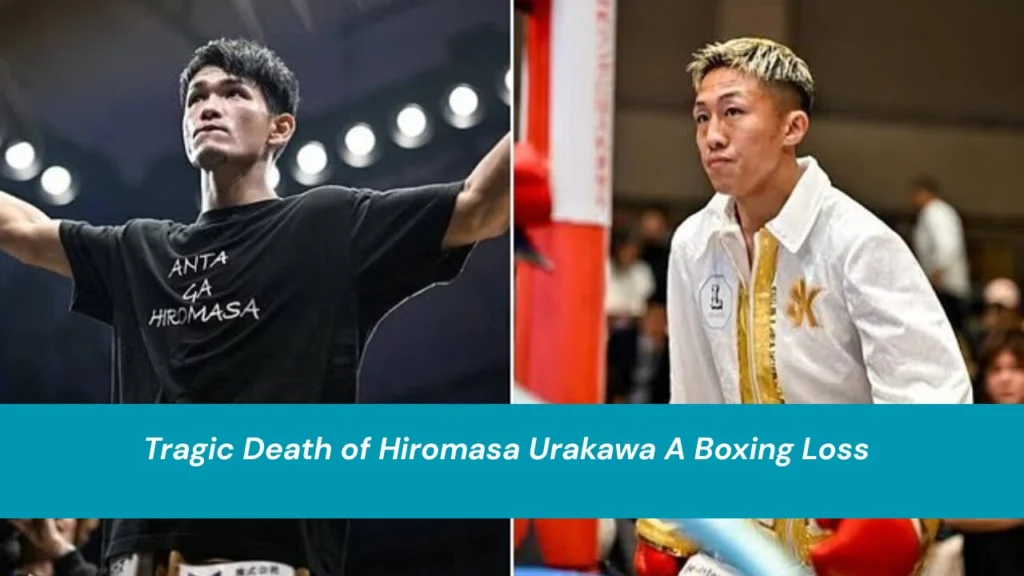The boxing world is reeling from the devastating news of Hiromasa Urakawa’s death, which makes him the second boxer to lose his life after competing in the same Tokyo event. This tragic development has sparked deep concerns about the safety protocols in combat sports, particularly in boxing, where the risk of head injuries remains one of the sport’s gravest dangers.
This article will examine the events surrounding Urakawa’s passing, the ripple effects on the boxing community, the medical realities behind such injuries, and the urgent calls for reforms. It will also highlight potential measures to enhance the safety of fighters, ensuring their well-being without compromising the sport’s integrity.
The Events Leading Up to Hiromasa Urakawa’s Death
On August 2, 2025, at Tokyo’s iconic Korakuen Hall, Hiromasa Urakawa stepped into the ring to face Yoji Saito in what was expected to be a competitive and thrilling match. The bout was part of a major event that also featured several high-profile fights, including one involving Shigetoshi Kotari who would tragically meet a similar fate days later.
Urakawa, aged just 28, fought bravely but endured heavy punishment over the course of the fight. In the eighth round, he was knocked out by Saito. What seemed like a routine knockout soon escalated into a life-threatening medical emergency. Urakawa was rushed to the hospital, where doctors discovered a subdural hematoma, a severe brain injury caused by bleeding between the skull and the brain.
Despite undergoing emergency brain surgery, his condition did not improve, and he was pronounced dead shortly after the procedure. This heartbreaking outcome came only days before the death of Kotari, casting a shadow of grief and concern over the sport in Japan and internationally.
The Impact on the Boxing Community
The loss of two fighters from the same event is an unprecedented and sobering occurrence in modern boxing. The shockwaves were felt across the entire boxing world from fans and fellow athletes to trainers, promoters, and medical professionals.
The World Boxing Organisation (WBO) issued a heartfelt statement, extending condolences to the families of Urakawa and Kotari, while also acknowledging the urgent need to re-evaluate existing safety measures. The Japanese Boxing Commission responded with immediate changes, including reducing all Oriental and Pacific Boxing Federation title bouts from 12 rounds to 10.
While this rule adjustment may seem small, many experts believe it could significantly lower the cumulative damage sustained by fighters, especially in later rounds when fatigue sets in and defensive reflexes slow.
Understanding Subdural Hematoma
A subdural hematoma is a type of traumatic brain injury that occurs when a blood vessel ruptures between the skull and the brain’s surface. The resulting pressure can cause severe brain damage or death if not treated immediately.
In boxing, repeated punches to the head can cause this condition — either from one particularly strong blow or from accumulated trauma over the course of a fight. Symptoms can include:
- Severe headache
- Confusion or disorientation
- Nausea or vomiting
- Slurred speech
- Loss of consciousness
The injury is especially dangerous because symptoms can sometimes develop gradually, meaning a fighter may not realize the seriousness until it is too late. In Urakawa’s case, the rapid onset of symptoms meant there was little time for effective intervention.
The Urgent Need for Safety Reforms in Boxing
The deaths of Urakawa and Kotari have intensified calls for reforms aimed at protecting fighters. While boxing is inherently risky, there are several steps that can be taken to minimize dangers without diminishing the sport’s competitive nature.
Reducing the Number of Rounds
The Japanese Boxing Commission’s decision to shorten title fights from 12 to 10 rounds is a proactive step. Shorter fights reduce the total number of head impacts, potentially lowering the risk of severe injuries. Historically, many boxing matches were 15 rounds before being reduced to 12 in the 1980s for similar safety reasons.
Strengthening Medical Protocols
One of the most effective ways to protect fighters is to improve medical coverage at events. This means having multiple ringside doctors, advanced emergency equipment, and faster access to neurosurgical facilities. Fighters should also undergo mandatory brain scans before fights, especially if they’ve suffered recent knockouts.
Ongoing Safety Education for Fighters
Boxers need continuous education on recognizing injury symptoms, understanding recovery times, and avoiding pushing through dangerous situations. A well-informed fighter can make better decisions about when to continue fighting and when to stop.
Stricter Regulations and Monitoring
Tighter controls over weight-cutting practices, fight matchmaking, and pre-fight evaluations can also play a key role. Fighters who take extreme measures to make weight or accept mismatched bouts are at higher risk of injury.
Historical Perspective Boxing Fatalities and Safety Progress
While the deaths of Urakawa and Kotari are tragic, they are not isolated incidents in boxing history. Since the sport’s early days, fatalities have occurred due to head trauma, dehydration, and other fight-related injuries. Over the decades, governing bodies have made significant reforms from introducing mandatory standing eight counts to banning certain punches but the sport continues to wrestle with balancing excitement and safety.
The most well-known safety reform in recent decades was the reduction of title bouts from 15 to 12 rounds after the death of South Korean boxer Duk Koo Kim in 1982. The changes following that tragedy likely saved countless lives, and similar action may now be necessary in light of recent events.
Frequently Asked Questions
What happened to Hiromasa Urakawa?
He died after suffering a knockout against Yoji Saito on August 2, 2025. The injury to a subdural hematoma required emergency brain surgery, but he did not survive.
How common are serious injuries in boxing?
While the majority of fights end without major injury, serious cases particularly brain trauma are a recognized risk, especially in longer and more intense bouts.
What is a subdural hematoma?
It’s a dangerous condition where blood collects between the skull and brain, often from blunt force trauma. In boxing, it’s usually caused by repeated punches to the head.
What safety measures are being implemented?
The Japanese Boxing Commission has already reduced title fights from 12 to 10 rounds and is reviewing other safety protocols, including enhanced medical presence.
How can fans help promote boxing safety?
Fans can support reform-minded organizations, raise awareness about fighter health, and encourage governing bodies to adopt stricter safety standards.
Conclusion
The deaths of Hiromasa Urakawa and Shigetoshi Kotari serve as a sobering reminder of the inherent risks in boxing. While the sport has always carried danger, these tragedies highlight the urgent need for better safety measures, improved medical oversight, and ongoing education for fighters.
Honoring their memories means more than mourning, it means actively working to make the sport safer for future generations. With coordinated efforts from commissions, trainers, medical teams, and fans, boxing can continue to evolve into a sport where skill and courage are celebrated without sacrificing the well-being of its athletes.




